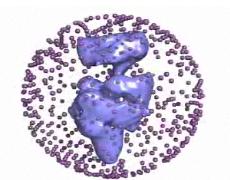It was revealed how "molecular machines" inside the cells begin to activate the genes in different stages of the cell's life. This discovery was published in November in the scientific journal Molecular Cell.

It was revealed how "molecular machines" inside the cells begin to activate the genes in different stages of the cell's life. This discovery was published in November in the scientific journal Molecular Cell.
The genes consist of DNA compounds. Double helices that contain the encoded information that the organism's cells need to produce proteins. In order to gain access to this information, it is necessary to "unfold" the double-helix structure of the DNA. and deploy each of the coils separately. Once the information becomes accessible, the genetic code is converted into compounds known as messenger RNA (mRNA) and these are used to produce the proteins. The cells need to produce certain proteins at different points in time during their lives to help them adapt properly in response to the changes that occur in their environment.
The new study describes precisely how a molecular "machine" called "RNA polymerase", which reads the genetic code and in response produces RNA-messenger compounds, begins its operation with a kind of "start-up" through activation proteins that specialize in the reaction It's real. The scientists discovered that the polymerase uses an internal, tightly controlled blocking system that prevents the activation of genes at times when they are not required by the cell.
Using an electron microscope, with the help of which the contents of the activity of bacterial cells are observed, the researchers discovered that the process of unfolding the DNA coils. It only starts when the polymerase undergoes a change, its responsible for an active protein, which the cell sends to the region of the gene that is required to act.
A protein whose action "starts" the polymerase activity by removing the "cork" that prevents the entry of the DNA. into the machine. The activation protein also causes the displacement of the DNA coils. so that they align opposite the entrance to the polymerase. From the moment of the occurrence of these two movements and the arrival of DNA. At the appropriate position, the polymerase machine begins to operate in order to prime the coils and read the genetic information so that the appropriate proteins needed by the cell are produced.
Xiaodong Zhang, the main author of the article and a professor from the Department of Life Sciences at Imperial College London, explains the importance of his group's findings: "Understanding the operation of the gene transcription "machine" called RNA polymerase, and "turning it off" when it is not required, provides us with a better insight than ever regarding the internal activity inside the cells, and the complex processes that occur in them for the production of proteins in a carefully controlled manner.
Professor Martin Buck, head of the biology department and one of the co-authors of the article, adds that understanding this process in bacterial cells is of particular interest because this process of gene transcription and protein production is what allows the bacterial cells to adapt, respond and thrive despite the changes occurring in their environment. "In other words, this is the internal process that occurs in bacteria and makes them good at surviving. Many bacteria cause inflammation and disease in humans, and it is difficult to eradicate them. RNA polymerase of the bacterium is a proven target site for antibiotics such as rifampicin, which has become resistant to many types of bacteria. Insights obtained from our research will now provide opportunities and strategies for designing new antibiotic substances," he concludes.
The announcement of the research institute

4 תגובות
Isaiah, today there are computers that are able to make decisions, so I have no doubt that chemical reactions can also cause a "decision". Example: A seed "decides" to germinate in contact with water.
To be precise, Isaiah is the servant of the God of Gaps.
It is very easy to reply that God is the solution to every problem. In the times before the study, the gaps were abundant and the god prospered, over time he was damaged and weakened.
Nicely said Isaiah...
I wish there were more like you in this place.
"An active protein, which the cell sends to the area of the gene that is required to be active." What intrigues me is how the mechanism works that makes the cell "decide" on launching the activation protein. Is it possible to describe a decision-making mechanism based on chemical reactions?